How to Sell on Etsy? A Step by Step Guide!
Etsy is a well-known eCommerce marketplace; it’s an online marketplace primarily built for “unique products.” This can be almost anything, from greeting cards and candles to bath bombs, clothes, or jewelry – as long as the things are handmade or antique (meaning at least 20 years old) or handcrafted.
Etsy has 1.7 million active merchants and 28.6 million active customers, and there’s certainly a market out there if you can make something people want to buy. If you have the right product and use the insider tips below, you will start making money from Etsy within days.
In this article, I will explain to you step-by-step how you can set up a store on Etsy and start selling, as well as how you can market your store inside and outside of the Etsy marketplace. Now let’s jump right into the details!
Read more:
- Best Platforms to Sell Your Products Online
- How to sell on eBay using Shopify
- How To Sell On Craigslist? Guide & Tips
- How To Sell on Facebook Marketplace
- How to Sell on eBay?
- Best Selling Items on Etsy
Should you sell on Etsy?
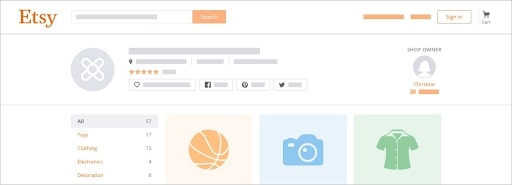
Of course, not all goods are for selling on Etsy. Etsy is not an all-in-one marketplace, like Amazon or eBay, where all sorts of products can be sold, mass-produced or hand-made. It has a special style; designed exclusively for artists and craftsmen to sell their handmade and antique items online. So before you spend your time and energy in building your Etsy shop, you need to make sure that your target customers are searching for your crafted products on Etsy.
Pros of selling on Etsy
It’s easy to start selling on Etsy
When you sell on Etsy, there’s no need to rack up your brains by selecting an eCommerce site or switching to a better one, creating an appealing theme for your online shop, and then customizing it to get the design you need.
You don’t even have to think about data security and all the ‘evil’ stuff that can happen when you build an eCommerce website from scratch. You can do anything with Etsy in a matter of minutes, without any technical expertise. Only fill out a couple of forms, and you’re good to go.
Whomping customer base
While Amazon recently launched Handmade at Amazon, Etsy is still the main destination people think about when they want to buy something handmade. By 2019, Etsy had about 2.5 million vendors and 39.4 million active shoppers. Throughout December 2019, 224 million users landed on Etsy to buy art supplies and handmade jewelry. Some of these users began selling on Etsy, others — converted to active buyers.
Friendly community
The culture of Etsy is trustworthy. More than 40 percent of first-time buyers turn into repeat customers, returning to Etsy over and over again. There are also a few useful resources where business owners can share their experience with their peers:
- Forum where they can communicate with other members of the group of Etsy;
- Teams to share and get tips on running an eCommerce business in their area;
- Dedicated blogs for various countries;
- Online labs — videos where Etsy employees and stakeholders exchange some important knowledge.
A greater chance to be discovered
Handmade products listed on Etsy (or any other trendy marketplace like eBay or Amazon) have a better chance of attracting potential buyers. Especially if you’re new to Etsy.
Shipping overseas made easy
If you’re new to Etsy, you can ship globally. Once an order has been placed, you can purchase and print on-site shipping labels. This is especially convenient when it comes to shipping to foreign customers.
Etsy can help grow your existing business
There are plenty of advertisement choices on Etsy, such as sponsored listings, that can help you highlight your items in Etsy ‘s search results and make them more accessible to your target audience.

Additionally, there’s an Etsy Wholesale system that links vendors to larger companies. And the newly introduced Etsy Manufacturing service, which can help sellers find local production partners.
Etsy has advanced machine learning
The Etsy team has done a lot to create a successful search experience for its users. In July 2015, the so-called exploratory search was launched, a feature that created a more visual search experience, especially on mobile devices. Its technology has improved the click rate by 10%. A year later, in September 2016, Etsy purchased Blackbird Technologies to make Etsy’s search engine wheels look a little better with machine learning and artificial intelligence.
A mobile app
There is an Etsy app for iOS devices (iOS 9.3 or later required) and all Android devices (Android 4.1 and up required).

There are, in fact, two Etsy apps—one for sellers, the other for shoppers. Given that 65 percent of Etsy visits come from mobile devices, this is a strong tool. The Sell on Etsy app makes it easy to control your Etsy listings and orders on the go and stay updated when anyone buys your product or adds it to ‘Favorites.’ The Etsy Buyer app provides a seamless online shopping experience from mobile devices — notifies consumers when their item is delivered, accepts payments, shows shops nearby and more, and more.
Cons of selling on Etsy:
Just like any online selling platform, Etsy is by no means perfect; here are some drawbacks that you might encounter:
You aren’t paid instantly
You can opt to collect your payments on an annual, weekly, bi-weekly or regular basis, but once they’re “paid” according to our Etsy vendor sources, it takes about three days for the money to reach your bank. This isn’t ideal if you have to pay for your shipping upfront.
It’s primarily a US website
UK sellers, unfortunately, are at a disadvantage compared to those based in America – whether this is due to the increased shipping time, more expensive shipping, or prices.
You get charged fees monthly
It can be difficult to keep track of all the listing fees, commissions, and payment charges when your store is up and running, and they’re billed in a big chunk once a month. Remember to set aside money to pay for it, and don’t treat everything you get paid out of Etsy as a profit.
You don’t have complete control
Creating a shop on Etsy is not the same thing as having your own website. You don’t have full control of every aspect of the design, so it’s not as easy to create your own personal brand. Plus, Etsy can technically kick you off the site at any time (though they won’t do that unless you break the rules).
Also keep in mind that if you want to turn your Etsy store into a fully-fledged business, Etsy stores are often not considered ‘professional’ as having their own website. Etsy stores are a great place to start your business, but if things get going you may want to move to an independent website.
Learn more: Do You Need A Business License to Sell on Etsy?
How To Start A Shop On Etsy Step-By-Step
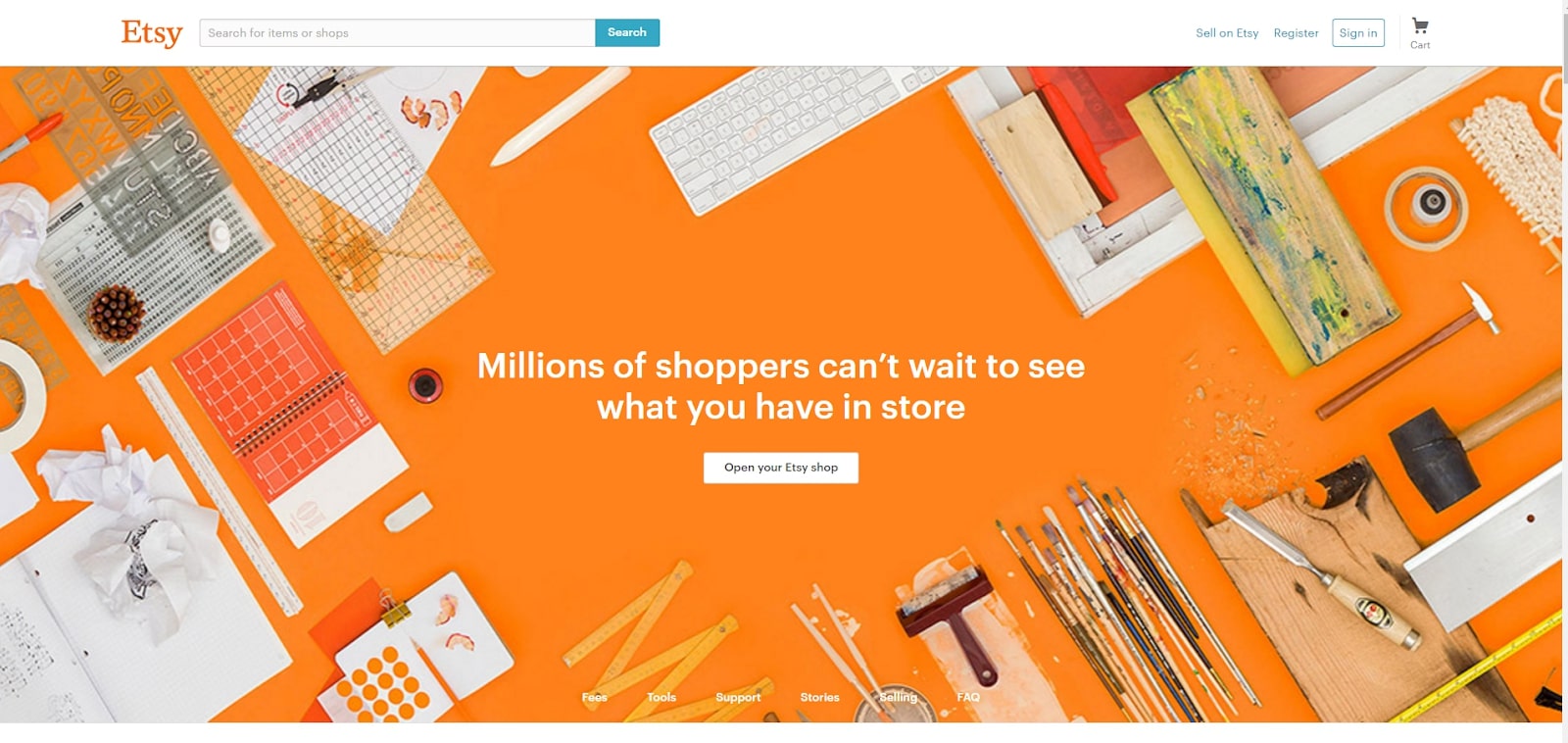
Choose Your Products & Brand Name
Shop name & first product are not things you want to find out while you sign up; you should look for one beforehand, particularly because it’s hard to change your shop name later.
Naming Your Shop
Etsy’s Seller Handbook has a really clear guide on shop name considerations.
But there are a few things to bear in mind:
- Your account name and your shop name are two different things. In addition, there can be several stores in an account.
- You can set up an account and click “Sell on Etsy” to go through the setup process to test the availability of your name.
- Make sure to google your brand name to avoid conflicts.
- Go ahead and look for a domain registrar (like NameCheap or GoDaddy) and buy a domain name for use in the future – even if it’s not required for your Etsy Store.
The shop logo and description are not mandatory to get going – but it’s a good idea to work on it before setup.
Selecting Your First Product
It costs you $0.20 to list a product on Etsy. And if you start a shop, you probably already have your first product in mind. But if you want to list your product, you’ll need to decide a few things in advance. This has to comply with the marketplace rules of Etsy.
You’re going to need pictures.
- Use high-quality image files (JPG, PNG or GIF) that are at least 570px wide but 1000px recommended.
- Use photos with natural or diffuse lighting – not flashing lights.
- Your images will be in thumbnails with the option to zoom in and view full-size.
- Have a copy of your product description ready. Seek a compromise between transparency, conciseness, description, and descriptiveness.
- Do the same with the title of your product – make sure it is concise, easy-to-remember, and readable.
- List the categories for your product and use this page to search for product categories and descriptions.
Read more: What to Sell on Etsy? Top 16+ Best Selling Items on Etsy
Etsy also has this resource to create “tags” for your product. Once you have chosen names for your shop and products, you can start setting up your shop. Everything during setup can be easily changed after setup.
Setting Up Your Store
Now let’s set up an Etsy shop together.
Etsy’s Onboarding
Etsy’s shop signup process is simple and straightforward. Start setting up your account by clicking “Sell on Etsy”.

You’ll be directed to a setup process that begins with general preferences.
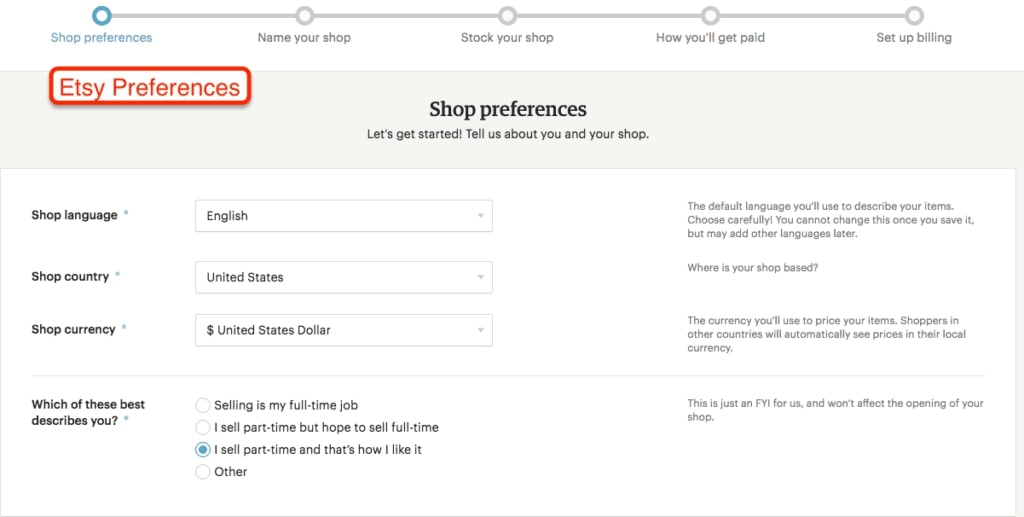
You need to name your shop.
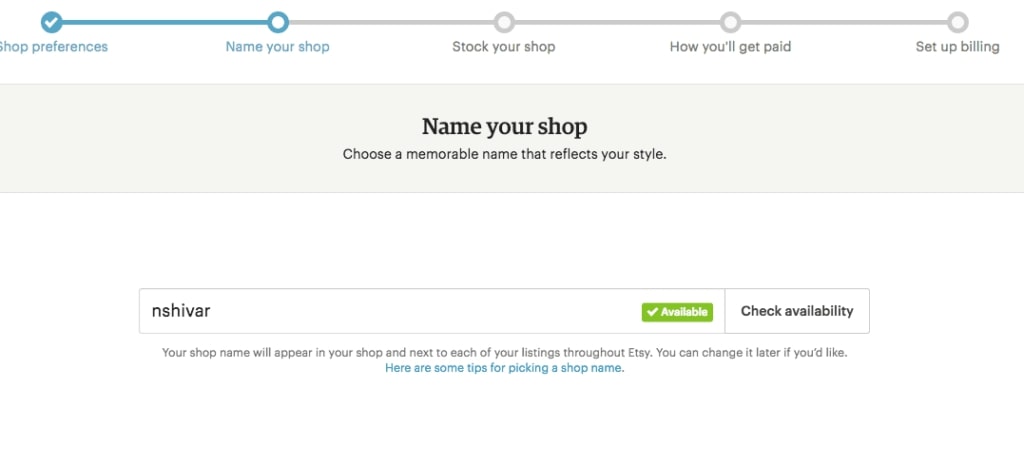
Next, you’ll need to set up at least one listing.
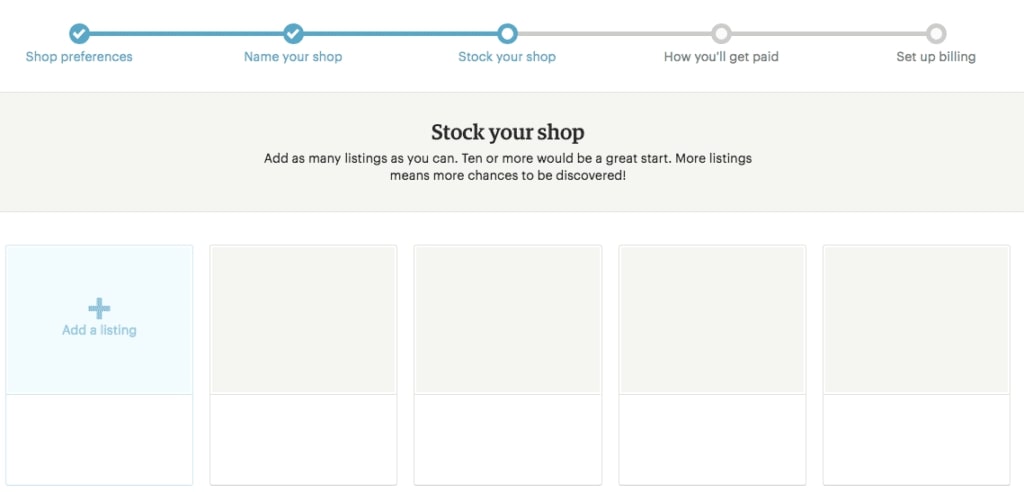
When you add a listing, you’ll be directed to the listing screen. Fill out all the required fields the best you can, but don’t worry, you can edit your listing later.
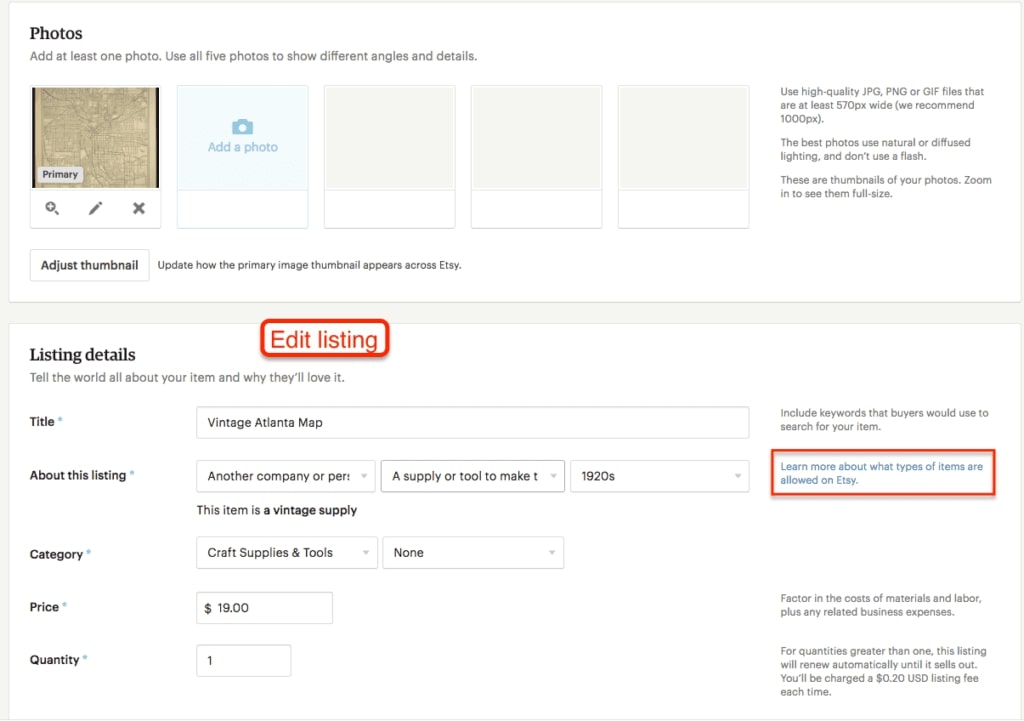
Then you need to enter search terms for your listing.

After the main listing page, you’ll come to shipping preferences, fill out the information.
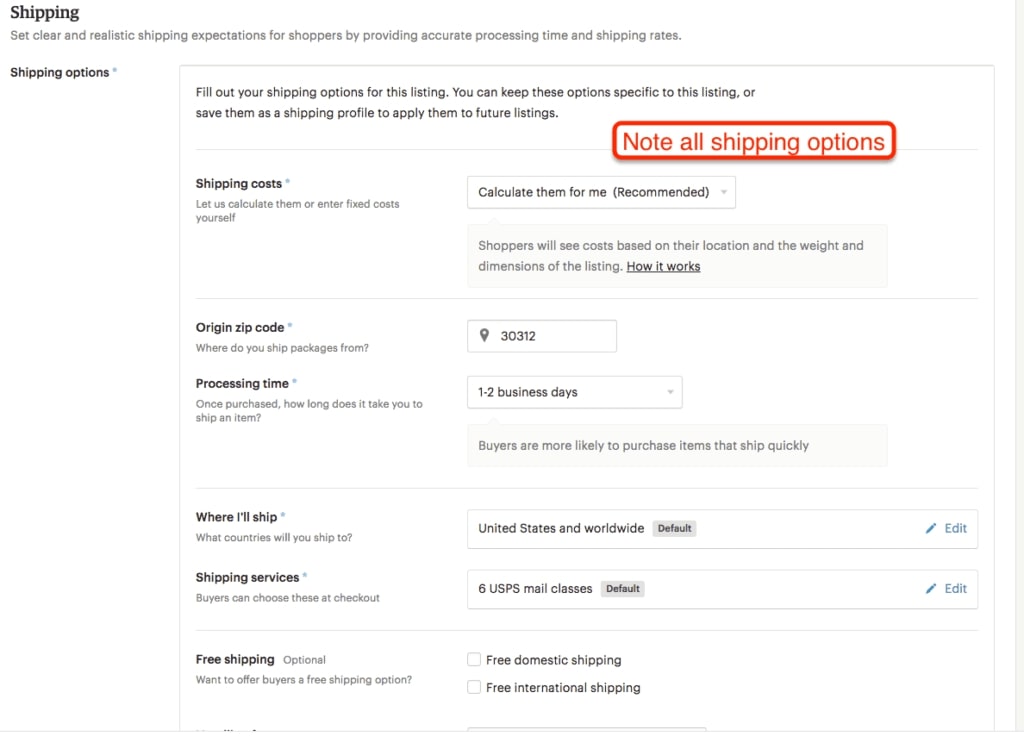
Lastly, you need to provide your bank information (for deposits) and credit card information (for listing payments). Once you finish, confirm your location and open your Etsy store!
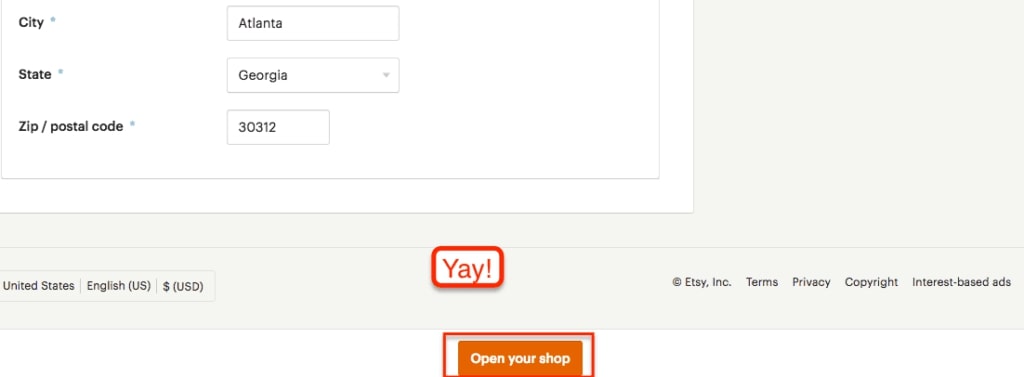
Listing More Products
Once you’ve opened your shop, you can go to your Listings Manager to add, modify and manage your listings.
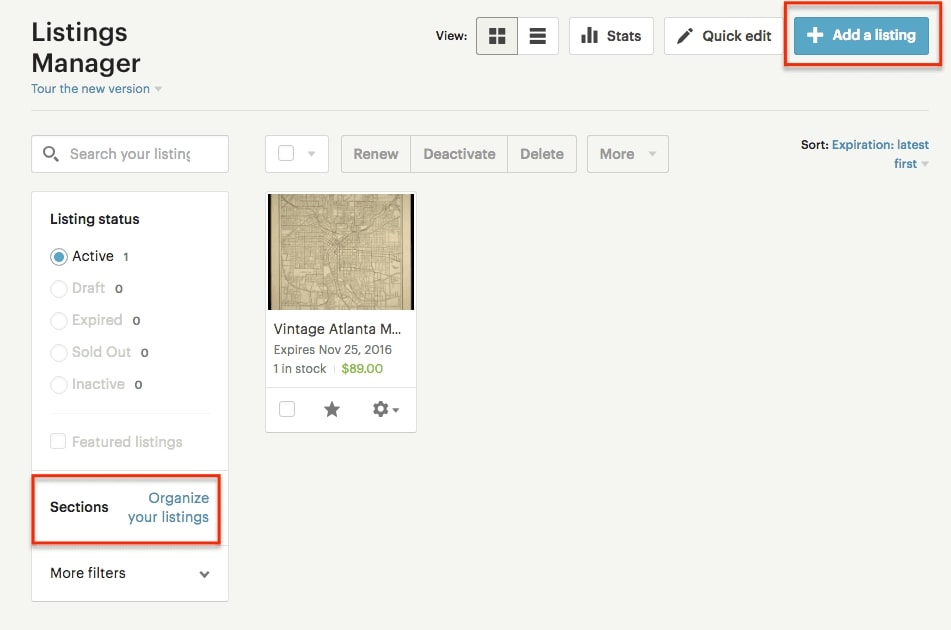
When you manage your listings – make sure to use “Quick Edit” and “Organize your listings” to save time and help customers sort your products. Here are Etsy’s rules and fees for listings.
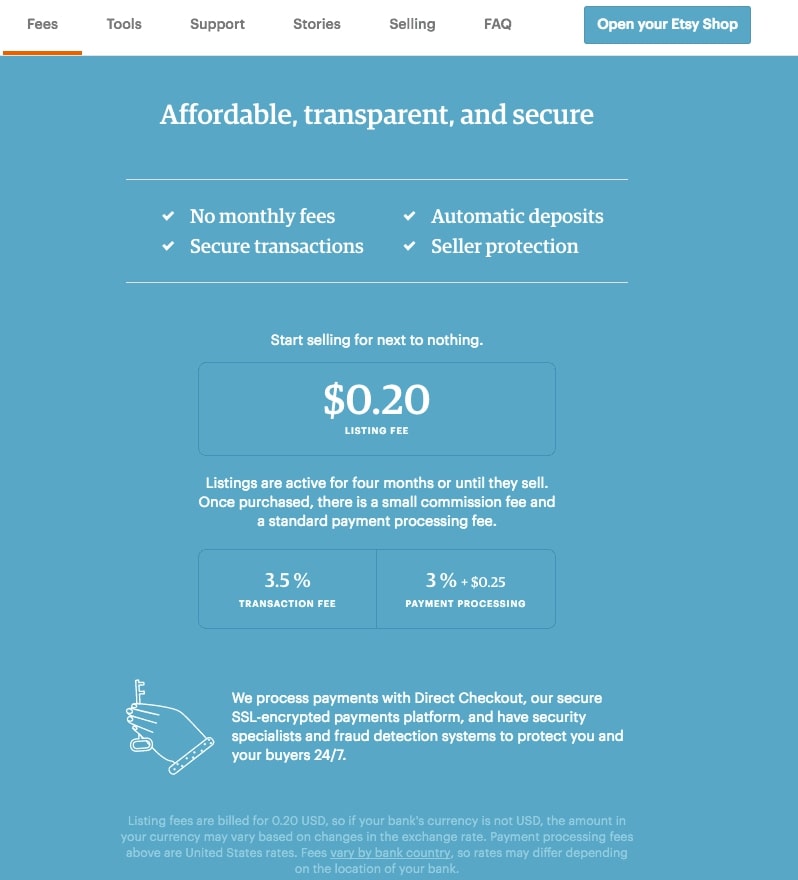
Although any single listing is not costly, dozens or hundreds together will add up because it expires after 4 months. Etsy’s model allows you to concentrate on a few high margin bestsellers. There is not lots of room on Etsy for low-volume cross-selling items. That said, Etsy’s Listing Manager allows you to quickly deactivate, renew, or delete items as you decide on your merchandising.

Recommend: How to Start an Etsy Shop
Changing Options & Settings
If you compare your Etsy store with platforms like Shopify or WordPress, you will see that your Etsy store has limited options for customization. That is the point, however.
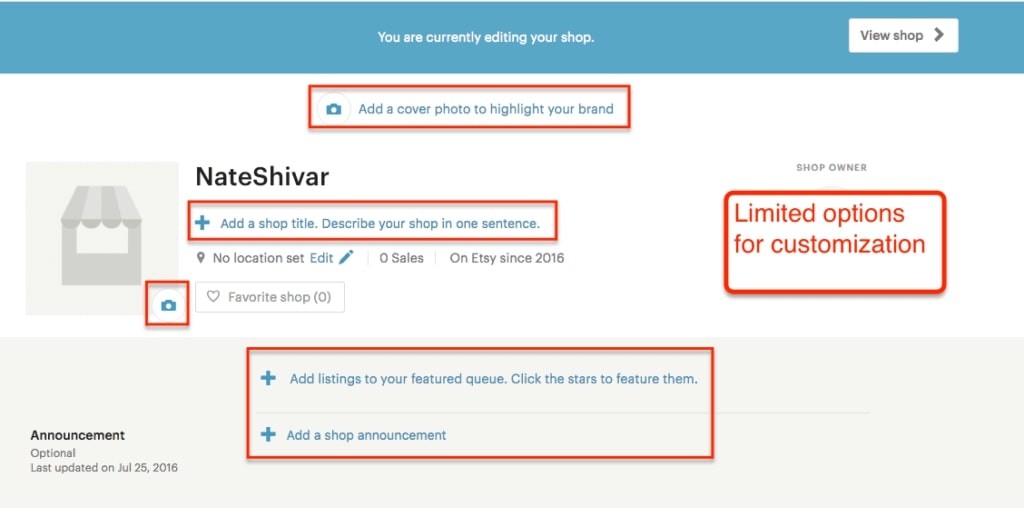
Limited choices ensure that you can concentrate on what matters to Etsy shoppers – your goods and your service. You should leave the design and features of Etsy. That said, you’ve got options on Etsy. And the options that you have are worth spending time on.
Start with your homepage.
- Image cover – at least 1200px x 300px
- Title of the Shop – limited to 55 characters
- Logo of the shop – minimum 500px x 500px
- Featured listings
- Announcements
But don’t forget that there are a number of other sections as you scroll down on your main edit page. You can start with your About page main page. Keep in mind that what you’re putting here isn’t just to tell people about yourself, but also to increase trust with your brand and sell your product.
Bear in mind that many (if not most) shoppers would be scanning on a mobile device. Ignore low-resolution images and “text blocks.” Keep videos concise. Add links to your other channels.

Next, you need to set up your Shop Policies. They’re dull, but they’re important to a lot of buyers. Mind a couple of items as you write your store policies:
- Even though customers trust Etsy, they don’t know you, your product, or your operation.
- Many very straightforward policies are better than other complex or conditional policies.
- Try looking at your policies as a new customer – not from your viewpoint or operation.
- Don’t fix issues that don’t exist yet.
- Using policies to provide customers with a straightforward process from the moment they click the purchase button until the order arrives at their door.
Keep in mind, too, that policies set expectations which, in turn, influence reviews. Simply having policies boosts your placement in Etsy search, but having strong feedback and high expectations help even more. It’s all working together.
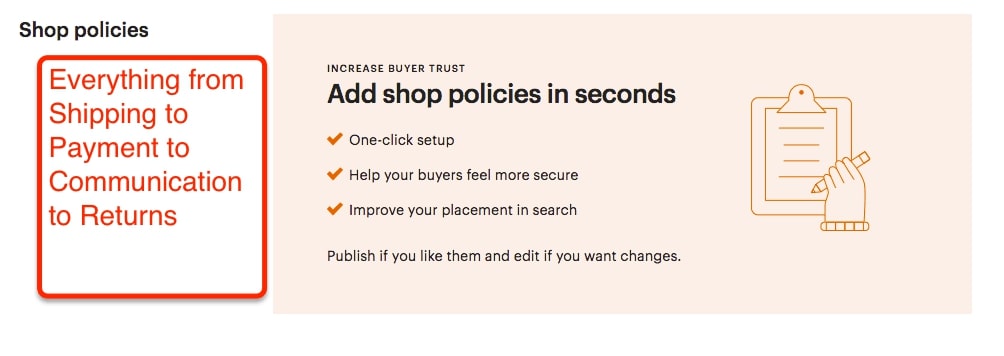
Finally, there is a special section for FAQs and European sellers. With FAQs – note, this is not a catch-all segment. Ideally, in the rules, you can answer any product questions in your product listing and shop questions. Check out my FAQ Best Practices post for suggestions.
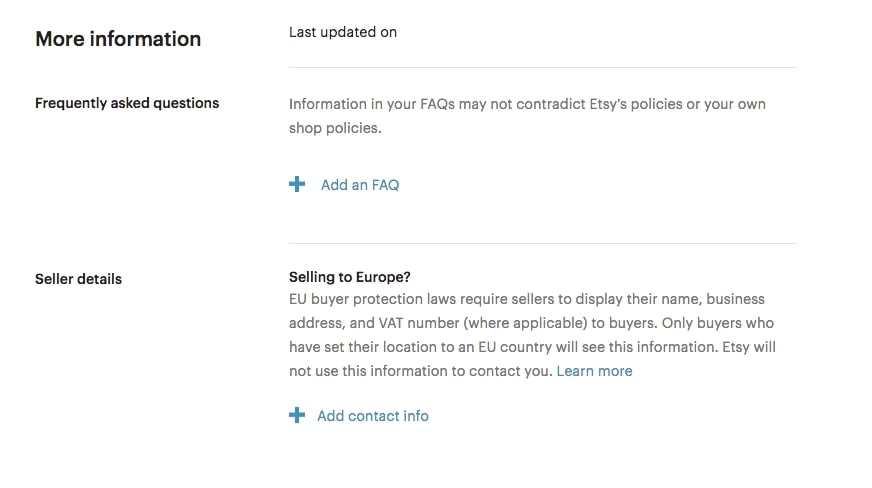
Etsy is constantly upgrading their apps and improving their features. Be sure to check for new shop settings and choices occasionally.
Using Etsy Shop Features
Your Etsy store comes with more than just a shop. It also lets you manage orders, show shop stats, print labels, generate coupons, and more.
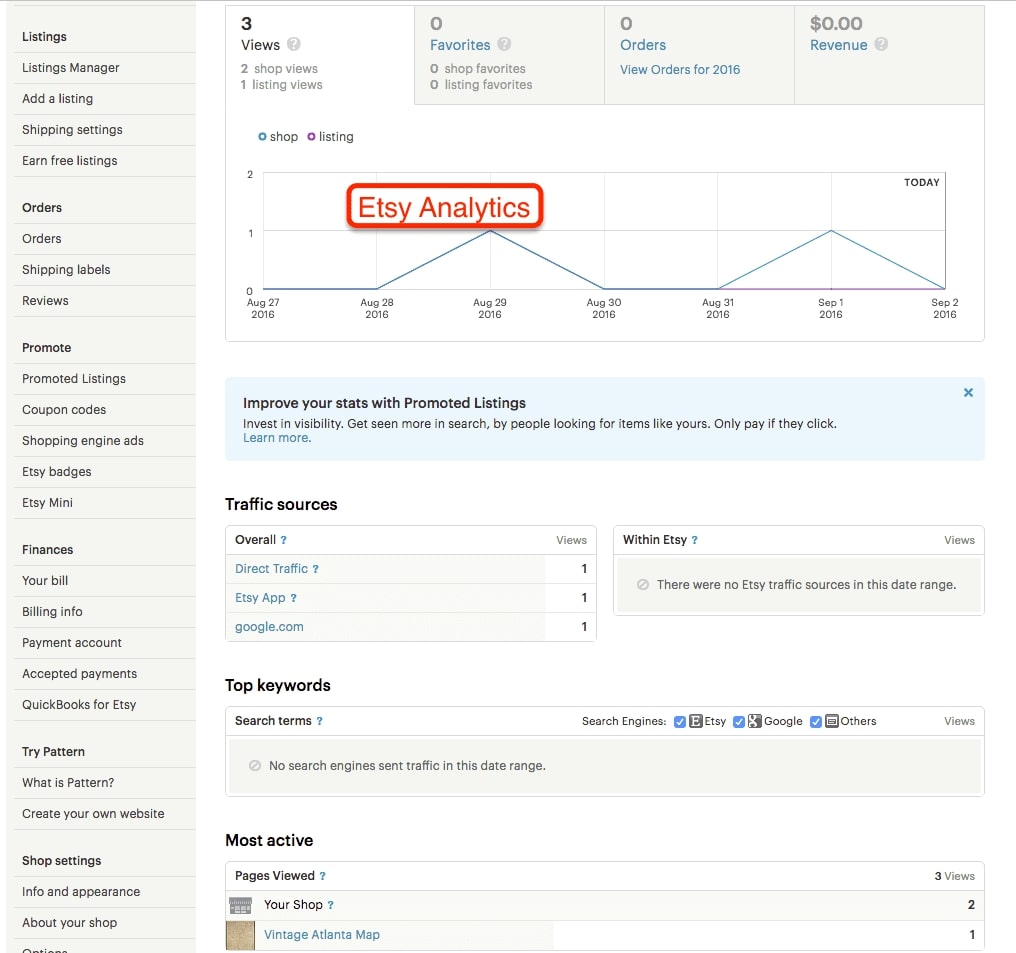
Explaining every feature is beyond the scope of this guide – but just keep in mind that Etsy has functions that not every seller will (or should) use – but that doesn’t mean that they’re not there. Like any new tool, success means reading the owner’s manual. Take a little time to just click and read the Seller’s Handbook. Yet you certainly want to use Etsy Analytics. You should use it not only for procurement decisions but also for marketing decisions. So marketing is what we’re going to find out about next.
Learn more: How to Sell Digital Downloads on Etsy?
Marketing Your Etsy Store
Opening a shop on Etsy does not guarantee sales. As of 2019, there were 2.5 million active sellers, with thousands more opening every day. And that doesn’t even include the rivalry anywhere else on the Internet.
And yet – you do have an immediate global market (if you ship internationally) within a few setup steps. Your job is to determine who exactly you are selling to and where you can advertise to attract their attention – and the answers to these questions will drive your marketing campaign.
On Etsy
Etsy’s greatest benefit is that they have Etsy Shoppers; their own audience. In other words, more than 20 million consumers are already shopping for Etsy– even if they don’t know about your particular store. It’s sort of like getting a stand on the iconic farmer’s market – people are heading to their destination. You just need to catch their attention once they’re there. You have a few options on Etsy.
Etsy Search
You will get visitors from Etsy search. Etsy’s search engine is somewhat different from standard web search engines such as Google or Bing. Etsy has their own algorithms – they’ve addressed how they go about search here. The rule of thumb, however, is to provide concise, memorable product names with detailed, understandable explanations. It means making the listings that you would like to buy if you were a customer.
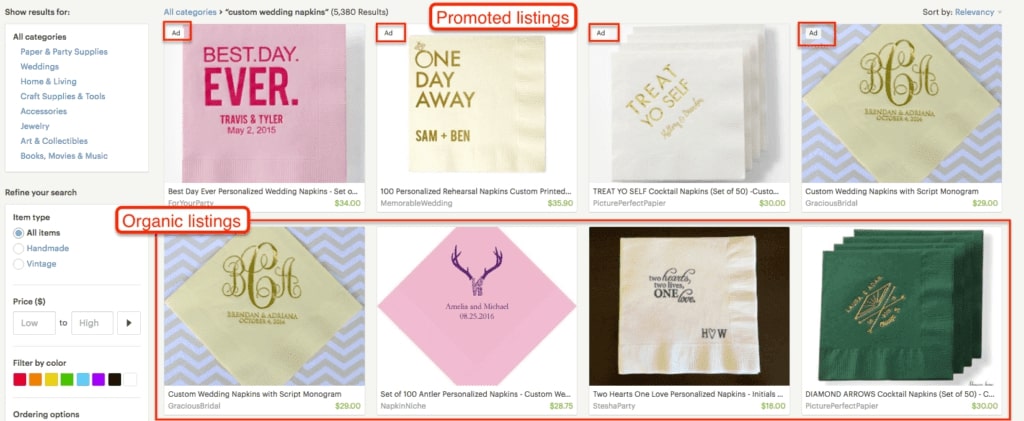
Etsy Promoted Listings
If you are new or have a decent profit margin, you can always pay to appear in Etsy search results. Keep in mind that paying for listings can have extra traffic & sales benefits. First, you get the customer’s data and feedback. This is invaluable when you first launch your shop. You can use it to boost your goods, your listings, and your overall marketing. Second, you get feedback that will help with Etsy’s search engine.
Etsy Affiliates
An affiliate program is a contract that charges a fee or percentage to someone who brings a sale to your shop. They are a perfect way to boost sales (because you just pay a charge to your affiliate company when you actually get a sale). But they can be difficult to set up & police for fraud.

But Etsy has an internal affiliate network that you can use. Etsy does professional research and you can use the affiliate network to hire partners – such as niche forums, sponsorship opportunities, etc.
On Social Channels

Another benefit of selling on Etsy is that Etsy pages work very well on social media platforms.
Etsy and Pinterest are a match made in marketing heaven. Each description you write and every picture you take on Etsy will fit well on Pinterest. It’s also a perfect place to market research and spend on supported pins. Here’s our guide on how to use Pinterest for selling.
Yes – Facebook is becoming more and more “pay-to-play” if you’re a business. When you rely solely on organic sales likes on your business page, you won’t get a lot of exposure. Yet in a way, that’s all right. Facebook provides an enormous number of paying options. You can create highly targeted audiences and test your ads on a very low budget.
Twitter/Others
Dozens of niche social networks are here to sell your goods. The secret to that is to go where the target audience is. So it goes back to choosing who you’re selling to. It may be Wanelo, Polyvore, or Snapchat. Maybe it’s Twitter or Reddit. It all depends on your audience and on your product.
Other Channels
When you move beyond Etsy & social media networking – you’ll need to start thinking about your domain and your brand for the long-term. So if you start creating your brand through organic search, paid advertising, and PR – you want to make sure you ‘re building your brand, not Etsy ‘s brand.
You’re going to want external links to go to your domain. You’re going to want ads to lead to your domain with your own analytics & tags in place. You ‘re going to want your PR to send people to your website with your experience. But you don’t have to start the right way – you can understand and keep these channels in mind as you start your shop and build from there.
Organic Search / SEO
Your Etsy store will be indexed by Google / Bing. You can get traffic from Google / Bing – but much of it will be “branded” traffic (i.e. people searching for you rather than your products). Regardless of Etsy’s limitations and competition within Etsy, you are unlikely to rank in Google for volume product words (i.e. “cloth napkins”). And the niche words that you might rate for are likely to have zero volume (i.e. “handmade napkins of the 17th-century style”). Anyway, it’s worth a try to find out if your product can make it on search results.
PPC / Paid Media
You can (and really should) run small paid campaigns for your Etsy shop. But since you can’t incorporate your own analytics or conversion tags to your Etsy store, you can’t (and shouldn’t) expand these campaigns. Because most eCommerce transactions are “multi-touch” (i.e. people leave and come back later to buy) – you should be cautious about spending too much on either direct response or advertising ads. Either way – you can run test campaigns to get going and prepare larger campaigns.
Referrals / PR
Even small blogs and publications bring a surprising number of sales. It’s a great strategy to start with. However, one of the greatest long-term benefits of PR is the actual linkages. Those drive both Google/Bing visibility and referral traffic long after the post goes live.
Don’t ever turn down a good link to your Etsy store if that’s all you’ve got. But don’t spend too much time investing in outreach until you make sure that referrals can link to your custom domain instead of etsy.com/shop/[your store].
Final Words
It will be difficult, at the beginning, to launch an Etsy store, but with efforts, you will be able to create a successful business and make decent money. I hope this guide has given you a good start to kick off your Etsy business! Please feel free to leave comments below for further discussion. :-)
Related posts:
New Posts






